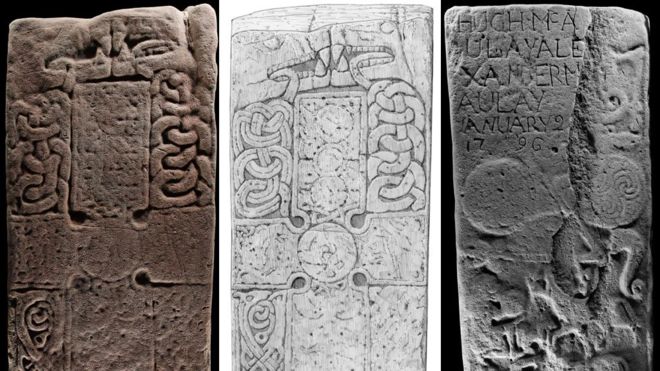New discovery of 1,200 year old Pictish standing stone found in Highlands of Scotland
A Pictish standing stone with unique carvings has been discovered in an old burial ground near Dingwall (Scottish Gaelic: Inbhir Pheofharain) in the Highlands of Scotland. The 1,200-year-old standing stone has carvings never before seen on a Pictish stone. The discovery of the stone was originally made by a member of North of Scotland Archaeological Society (NOSAS) and was then referred via a regional archeaoligist to Historic Environment Scotland and the Pictish Arts Society. John Borland President of the Pictish Arts Society said, "On one side, the two massive beasts that flank and surmount the cross are quite unlike anything found on any other Pictish stone. These two unique creatures serve to remind us that whilst we can at times draw parallels between different carved stones, Pictish sculptors had a remarkable capacity for creativity and individuality." An interview with John Borland on BBC Radio Scotland can be heard on this link to the NOSAS website. NOSAS and the Pictish Arts Society have launched a crowdfunding campaign to raise £20,000 towards the cost of conserving the stone.
The Picts were a Celtic society of farmers and hunters and the remains of Pictish art, language and society can be found throughout north and eastern Scotland. The Picts were made up of different tribes who became increasingly united for defensive purposes against the threat of first the Romans and later with the invasion of the Angles and Saxons which saw the emergence of the Kingdom of Northumbria.
This threat of invasion was emphasised by the victory of the Angles at the battle of Degsastan with the defeat of King Aedan of Dalraide. This victory saw a period of Northumbrian expansion. Between 657 AD and 685 AD they occupied the southern lands of the Picts. However, this rise in the fortunes of Northumbria was curtailed by the emergence of Bridei, who was the son of King Neithon of Strathclyde. King Bridei Mac Bili led a force of Picts which engaged in battle with the Northumbrians under King Ecgfrith on 20th May 685 AD at Nechtansmere. With a series of brilliant manoeuvres they defeated the Northumbrians killing King Ecgfrith in the process. There then followed a continued period of decline for Northumbria until their eventual merger into the rising kingdom of England. The Picts went on to become a crucial part in the forging and establishment of the nation of Scotland.
Image: Carvings on 1,200 year old Pictish standing stone courtesy of John Borlandand NOSAS.






